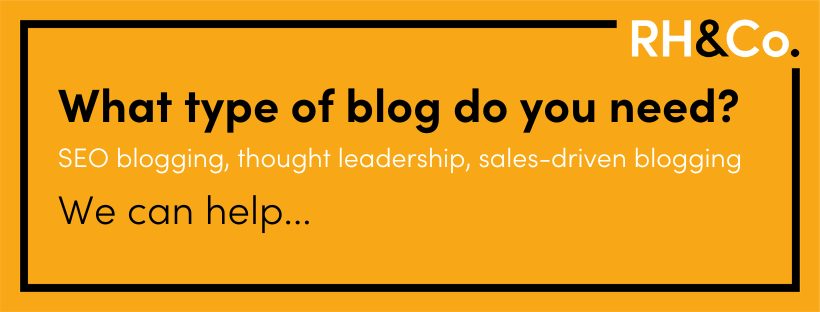

When is blogging most effective for business?
With the number of marketing channels and tactics increasing on what feels like a weekly basis, choosing which to focus on is a challenge for all in-house marketers and founders. Each one has its merits. Each one its challenges. But which will be the right choice for your business?
In today’s post we’re looking at blogging – an old school staple that has stood the test of time for a very good reason – and trying to answer the question, “When is blogging most effective for business?” Because although there are many benefits of blogging for virtually any business, there are some situations that will benefit from a blog in particular.
TL:DR
- When someone is making a considered purchase
- If you’re selling a complex product or service
- For businesses with a long sales cycle
- Where community building is important
- Deciding whether a blog is right for your business
- The results we’ve generated for our blogging clients
When someone is making a considered purchase
If you’re buying a pint of milk, you’re not likely to think all that hard about it. You’ll nip into the nearest shop, decide between skimmed, semi skimmed or whole milk, pick the bottle size you want and that’s that.
If, however, you’re thinking about buying a new laptop – or car seat for your newborn, or choosing a building company for an extension – you’re likely to spend much more time on the decision-making process.
“The more considered a purchase someone is making, the more effective a blog can be in providing the information they need to make a good decision.”
Ditto in the B2B world. As a marketing manager, you might spend a couple of hundred pounds on merch for an event without worrying too much about it. But if you’re taking on a new copywriting agency or ESG consultancy, you’ll want to do a lot more research.
The more expensive a purchase is, or the more critical it is to get that decision right (remember the newborn’s car seat), the more considered it will be. And the more considered a purchase someone is making, the more effective a blog can be in providing the information they need to make a good decision.

If you’re selling a complex product or service
If a product or service is complex, your audience will need more information in order to make a good decision than if the purchase were simpler. Blogging can be a useful way to deliver this information in bite size chunks that lead the reader along the buying journey from being stuck to making a purchase decision.
The important factor here is being clear about anything that your reader won’t understand. Explain the jargon. Explore the benefits. Look at options – which one would best suit which type of person or business? Remember, you need to be honest and provide as unbiased a view as possible in order to add genuine value.
Don’t be afraid to explain why your type of product or service may not be a good fit for someone. If they leave your blog post with a sense that you have provided good information, they might still recommend you. The alternative is you twist their arm and they end up unhappy, causing you more problems than the sale was worth.
For businesses with a long sales cycle
If your business has long sales cycles, you’ll know how tricky it is to balance staying on your prospect’s radar without bugging them. The longer that sales cycle is, the easier it is for them to get distracted somewhere along the way.
A blog can not only help lead those prospects from one stage of the buyer journey to the next but can give you an excuse to proactively get in touch.
Imagine you’ve met someone at a conference. They seemed interested in one of your products or services. You chatted, exchanged business cards and connected on LinkedIn. This is not the time to go in with a hard sell. Instead, sharing a relevant blog post – perhaps one that you know will help them with a challenge they mentioned – will demonstrate both your expertise and your desire to help them.
Ideally, you’ll want to create a blog post for each stage of the buying process so that you have a series you can send at appropriate times. A good place to start if you’re looking to equip your sales team is comparison posts that weigh your product or service against competing options, and objection busters that answer key questions your prospects are likely to have.
Blogging can take anywhere from 9 to 18 months to demonstrate a real return on investment, so you need to know that you’re not going to give up or have your budget pulled after three months.
Where community building is important
Even in industries such as fashion and lifestyle, where products may be fairly simple, relatively low cost and purchased more on a whim than through serious consideration, blogging can still be used to build a brand community. A number of brands do this very well, for example Fat Face, Fjallraven and our clients Tom & Teddy.
Community building blogs usually feel a bit more like lifestyle magazine articles. They build atmosphere, inspire their readers, make them feel that they are part of something bigger. You can also include posts that showcase how to use your product or service to full effect, or case study based articles that demonstrate how others have benefited from them.

Deciding whether a blog is right for your business
If you’re still reading, it’s probably because you’ve recognised one or more of the scenarios above and you’re feeling broadly more confident that blogging could add genuine value for your business. Now it’s time to look more closely at the specifics. Because to make blogging work, you have to put in the effort.
So ask yourself…
Do you have a clear strategy?
There’s no point bashing out a few hundred words and hoping they’ll stick. A blog needs to sit within a clear content strategy, with a well defined audience and an idea of the outcomes you want it to deliver. You need to understand what part of the funnel you’re writing to, how you’re going to track results and plenty more besides.
Are the relevant people willing to get involved?
Whether you’ll be in charge of writing the blog yourself or you’ll be managing the process – for example with the support of an internal copywriter or an external freelancer or copywriting agency – you’ll probably need support from other people in your organisation.
For example, if you’re creating bottom of funnel (BOFU) blog posts that are fairly sales oriented, you’ll want input from your sales team. If you’re heading down the thought leadership route, you’ll want to talk to your subject matter experts. After all, thought leadership needs more than good writing, it needs good thinking.
If these people aren’t likely to help, you’re going to be struggling from the start.
Have you got / set realistic expectations?
Blogging can absolutely be a great lead generation tool. But it tends not to generate instant results in the way that, for example, a Google Ads campaign might. As we’ve mentioned already, blogging can take anywhere from 9 to 18 months to demonstrate a real return on investment, so you need to know that you’re not going to give up or have your budget pulled after three months.
The results we’ve generated for our blogging clients
As with any marketing tactic, there’s no guarantee that a blog will generate the results you hope for. We don’t believe in promising a 10x on leads because there are just too many factors involved. But we do know that with the right strategy, blogging can make a huge impact.
Tech founder Tom Riglar, who started both Morrow and Moropo, worked with us to produce thought leadership and sales blogs.
He said: “As experts, we really know our stuff but struggle to communicate that expertise to the outside world. Rin and her team have transformed the way we tell our story.
“Content marketing is a long term strategy but we’re already benefiting from an increase in the quantity and quality of leads, better brand awareness and a clearer focus on who our prospects are.”
At healthcare startup Blueheart, we used SEO blogging to increase their website traffic from 5,000 to 30,000 visitors per month within the first six months of working with them.
Camiel Roex, their Head of Growth, said: “Organic visits are the most stable part of Blueheart’s acquisition funnel… RH&Co helped us generate massive results over a span of a few weeks, and that’s just from the increase in traffic on the blog.
“We can run a full content marketer’s job in one hour a week instead of 20 hours. And we don’t have to hire someone full-time, which is important for a startup.”
If you’d like to talk more about whether blogging is right for your business – and what type of blog will generate the best results – get in touch with us today.
Back to hompeage








